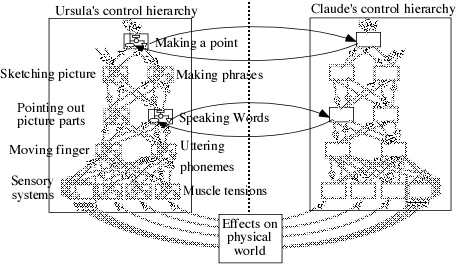3. Perceptual Control Introduction
4. Perceptual Control and imagination
5. Hierarchic Perceptual Control
9. Degress of Freedom in the individual
10. Degrees of Freedom in the organization
11 Modes of Perception (Reprise)
A few words on Communication
 |
This section of the talk sketches a few highlights of the Layered Protocol (LP) theory of communication, which has been applied to Human Computer Interaction. Here, it is approached as a facet of Perceptual Control Theory (PCT), though it was developed quite independently from different basic principles. There is a founding motto for LP, as there is for PCT. According to LP, what one tries to do in communication is to bring one's belief about one's partner to some reference state and maintian it there. |
Reasons for communicating
Communication is always to alter the partner's information state,
which may result in one or more of
| 1. (INFORM) | A change in one's own belief about the partner's beliefs, which can be used to assist later communications. |
| 2. (COMMAND) | An action by the partner that affects one's perception of the world outside the dialogue |
| 3. (REQUEST) | The provision of information by the partner. Essential for exploring. |
| The partner need not be cooperative. The "partner" may be the enemy. The same reasons apply. Only the methods change. | |
We argue that there are three fundamental reasons for communicating: to get the partner to believe something (which may later be useful), to get the partner to perform some action, or to get the partner to provide information. If the partner is cooperative, there are many techniques involving language that allow the partner to determine what you want and to satisfy your wishes. But the partner may be a competitor or an enemy. Even then, the same reasons apply, but you try to satisfy them by other means. Often, the enemy should not even know that you are communicating intentionally (see: Side Effects—deception).
A Layered Protocol hierarchy between 2 people
(Ursula and Claude can be read equally well as User and Computer)

It was earlier noted that the world we perceive is one we construct to mirror our hierarchy of Perceptual Input Functions. For each PIF there is a Complex Environmental Variable (CEV) in the world. As the output of one PIF is part of the input to others at a higher level, so any CEVis an aspect of CEVs at higher levels. In communication, the same applies, except that the CEV is in the partner, rather than in an inanimate world. The CEV now is a structure within the partner that corresponds to the ECS (in LP a "protocol node") in the originator.
Our communicative acts affect the physical world, and we perceive them as being interpreted at the appropriate level by the partner. Through feedback, the originator can determine whether a message (a communicative act at some level of the hierarchy) is having the intended effect, or whether more acts are necessary to achieve the desired result. The originator‘s belief, and thus the nature of the necessary messages, changes continuously, and an outside observer cannot always determine what messages are being communicated.